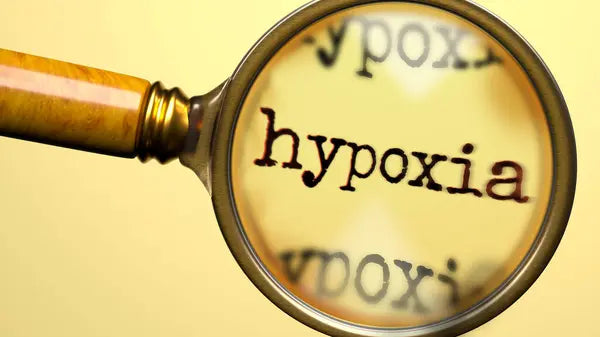How Oxygen Deficiency at the Cellular Level Creates a Cascade of Health Problems
In medical circles, there's a growing understanding that most chronic diseases share a common underlying factor: cellular hypoxia. This condition, characterized by insufficient oxygen at the cellular level, may be the missing piece in understanding why chronic illnesses have become so prevalent in modern society.
What Is Cellular Hypoxia?
Hypoxia occurs when cells don't receive adequate oxygen to function optimally. Unlike the dramatic oxygen deprivation that occurs at high altitudes or during drowning, cellular hypoxia is often subtle and chronic. It develops gradually, creating a cascade of dysfunction that manifests as various health conditions.
At the cellular level, hypoxia primarily affects the mitochondria – the tiny powerhouses responsible for producing ATP, the energy currency of life. When these cellular engines don't receive sufficient oxygen, they begin to malfunction, leading to decreased energy production and increased cellular waste accumulation.
The 90% Connection: How Hypoxia Underlies Chronic Disease
Research suggests that cellular hypoxia underlies approximately 90% of chronic health conditions. This staggering statistic makes sense when you consider that oxygen is required for virtually every cellular process in the human body. Without adequate oxygen:
- Energy production decreases: Mitochondria cannot produce ATP efficiently
- Cellular repair slows: Cells lose their ability to maintain and repair themselves
- Waste accumulation increases: Without proper oxygen, cellular waste products build up
- Inflammation rises: Hypoxic conditions trigger inflammatory responses
- Immune function declines: Oxygen-starved immune cells become less effective
Common Conditions Linked to Cellular Hypoxia
The list of health conditions associated with cellular hypoxia is extensive and includes many of the most common chronic diseases:
Cardiovascular Conditions
Heart disease, hypertension, and circulation problems often stem from oxygen-deficient cardiac and vascular tissues. The heart muscle requires enormous amounts of oxygen to pump blood effectively, and even mild hypoxia can impair cardiac function.
Neurological Disorders
The brain consumes about 20% of the body's oxygen supply. Chronic cerebral hypoxia contributes to cognitive decline, memory problems, depression, anxiety, and neurodegenerative diseases.
Metabolic Dysfunction
Diabetes, obesity, and metabolic syndrome are closely linked to mitochondrial dysfunction caused by cellular hypoxia. When cells can't produce energy efficiently, metabolic processes become disrupted.
Autoimmune Conditions
Rheumatoid arthritis, lupus, and other autoimmune diseases often develop when hypoxic conditions trigger chronic inflammation and immune system dysfunction.
The Critical 35% Threshold
Research has identified a critical threshold for cellular oxygen deprivation. When mitochondria are deprived of 35% of their required oxygen for just 48 hours, significant cellular dysfunction begins. This relatively small reduction in oxygen availability can trigger:
- Mitochondrial membrane damage
- Decreased ATP production
- Increased reactive oxygen species (free radicals)
- Cellular inflammation
- DNA damage and repair dysfunction
This threshold explains why seemingly minor oxygen deficiencies can have major health consequences over time.
Modern Causes of Cellular Hypoxia
Several factors in modern life contribute to widespread cellular hypoxia:
Environmental Pollution
Air pollution reduces the oxygen content of the air we breathe and introduces toxins that interfere with cellular oxygen utilization.
Sedentary Lifestyle
Lack of physical activity reduces circulation and oxygen delivery to tissues throughout the body.
Poor Breathing Patterns
Shallow, rapid breathing patterns common in stressed individuals reduce oxygen uptake efficiency.
Nutritional Deficiencies
Lack of nutrients essential for oxygen transport and utilization, such as iron, B vitamins, and antioxidants.
Chronic Stress
Stress hormones increase oxygen demand while simultaneously reducing efficient oxygen utilization.
The PATRIOX Solution: Addressing Hypoxia at Its Source
Traditional approaches to addressing hypoxia focus on increasing oxygen intake through breathing exercises, hyperbaric chambers, or oxygen concentrators. While these methods can be helpful, they don't directly address cellular oxygen utilization.
PATRIOX liquid oxygen water represents a revolutionary approach to combating cellular hypoxia. Unlike oxygen-infused water that quickly loses its oxygen content, PATRIOX delivers stable liquid oxygen directly to mitochondria within 30 seconds of consumption.
This direct cellular delivery bypasses many of the barriers that prevent traditional oxygen therapies from reaching the cellular level where they're needed most.
Recognizing the Signs of Cellular Hypoxia
Common symptoms that may indicate cellular hypoxia include:
- Chronic fatigue and low energy
- Brain fog and concentration problems
- Shortness of breath with mild exertion
- Slow healing and recovery
- Frequent infections
- Joint pain and stiffness
- Sleep disturbances
- Mood changes and depression
The Oxygen Advantage: Disease Cannot Exist
One of the most profound discoveries in cellular biology is that disease processes struggle to exist in oxygen-rich environments. Pathogenic bacteria, viruses, and even abnormal cells have difficulty thriving when tissues are optimally oxygenated.
This principle, first observed by Nobel Prize winner Dr. Otto Warburg, explains why addressing cellular hypoxia can have such broad health benefits. By restoring optimal cellular oxygenation, the body's natural healing and protective mechanisms can function as designed.
Taking Action Against Cellular Hypoxia
Understanding that cellular hypoxia underlies most chronic diseases is the first step toward better health. The next step is taking action to ensure your cells receive the oxygen they need to function optimally.
PATRIOX liquid oxygen water offers a direct solution to cellular hypoxia, providing bioavailable liquid oxygen that reaches mitochondria quickly and effectively. By addressing hypoxia at its source, PATRIOX supports the foundation of cellular health and natural healing.

